IDEX Online Research: Total US Jewelry Sales Rise in May, But Specialty Jewelers’ Sales Weak
July 17, 16
Total sales of fine jewelry and fine watches in the US market rose by a solid 4.2 percent in May 2016 when compared to May 2015, according to preliminary data from the US Department of Commerce. This gain was in line with mid-single digit monthly sales increases posted by the American fine jewelry market over the past seven months.
May is an important month for the US jewelry industry, since it includes Mother’s Day, the second largest selling period for jewelers during the year. Just over 9 percent of a jeweler’s total annual sales are generated in May, well above the 7 percent which are generated in a typical month without any special sales event such as Christmas or Valentine’s Day. Fine jewelry sales rose by an estimated 4.1 percent in May, while fine watch sales rose by a more robust 5.1 percent.
Preliminary May sales gains for specialty jewelers show that they are continuing to lose market share to other merchants – mostly multi-line retailers – who sell jewelry. Specialty jewelers, who generate a majority of their business from jewelry sales, posted a very modest sales gain of just 1.9 percent. This is a significant deceleration of sales gains posted in prior months this year by specialty jewelers.
Other retailers who sell jewelry – mostly multi-line merchants such as Wal-Mart, J.C. Penney, and others – posted a very strong 5.8 percent gain in sales during May.
Our outlook calls for more moderate sales increases – perhaps in the 3 percent range – over the next few months, primarily because comparisons are much more difficult against solid growth in the second half of last year.
Total Jewelry Sales Up 4.2 Percent in May
Total sales of fine jewelry and fine watches in the US market in May were an estimated $7.4 billion, according to the latest preliminary data from the Department of Commerce. May sales were well above the typical level of monthly jewelry sales – $5 billion or so – in the US market due to the strength of jewelry demand during the Mother’s Day selling period.
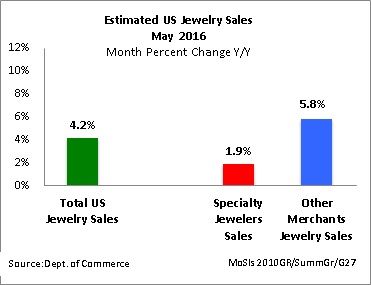
Specialty jewelers – These specialty merchants, who derive a majority of their revenues from the sale of fine jewelry and watches, posted a modest sales gain of 1.9 percent in May. Specialty jewelers’ sales represent about 40 percent of total US jewelry sales.
Multi-line merchants – Retailers such as Wal-Mart, Costco, and others who sell jewelry generated an estimated jewelry sales gain of 5.8 percent during the month of May. Jewelry sales through multi-line merchants represent about 60 percent of total US jewelry sales, a number that has been growing for several decades.
Consumer Spending on Jewelry Solid in May
Consumer demand for jewelry has continued to show growth, especially over the past seven months. In part, this is due to easy sales comparisons against last year’s weak gains in the early part of the year. In part, consumers seem to be spending more freely on jewelry, now that the US economy appears to be posting moderate, but consistent, growth.
Further, employment levels continue to strengthen. We also sense that some diamond promotions are beginning to have a positive impact on consumer demand; in addition, fashion jewelry remains a strong category at multi-line merchants. However, there appears to be some slowdown in demand for low-priced charm-and-bead jewelry, according to reports from both publicly held and privately held jewelers in our sample.
Figure 2 shows year-over-year percent changes in monthly fine jewelry and watch sales in the US market since the beginning of 2015. It is clear that jewelry sales gains have been showing positive momentum.
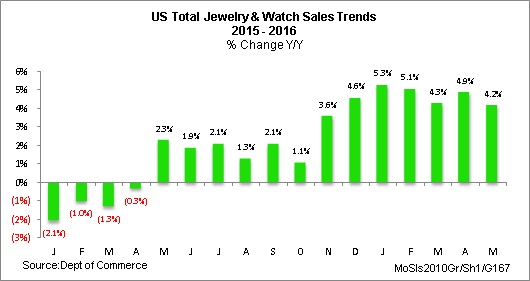
Fine jewelry sales (approximately 88 percent of the market) rose by an estimated 4.1 percent in May, while fine watch sales (approximately 12 percent of the market) were up by 5.1 percent. In most months, fine jewelry and fine watch sales track fairly closely. The graph below compares fine jewelry sales gains (red bars) to fine watch sales growth (blue bars). We note that the LGI/NPD Network showed that branded jewelry sales were down 14 percent in May and branded watch sales were down 12 percent; LGI noted that some of this was due to a quirk in the calendar, based on how their sample of jewelers report sales. However, demand for branded goods apparently was soft in May.
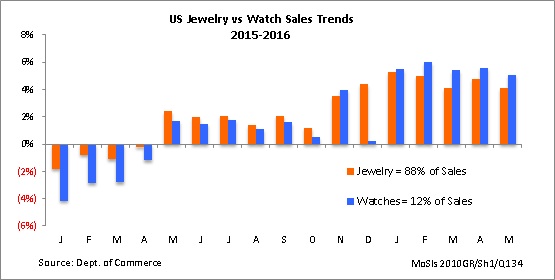
Specialty Jewelers’ Sales Growth Below Average
Specialty jewelers’ sales during May were an estimated $2.8 billion, a modest 1.9 percent increase over May 2015, as the graph below illustrates. This monthly sales gain was below the overall jewelry industry average (all US retailers who sell jewelry) of +4.2 percent for May. Specialty jewelers’ slowing sales growth is disappointing, especially when compared to weak sales in the first half of last year.
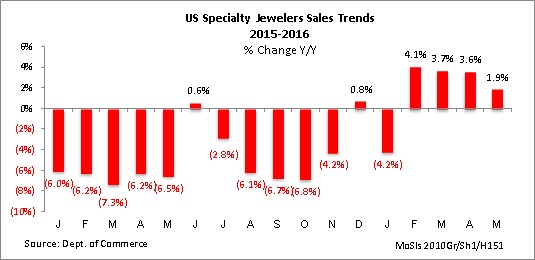
Jewelry Gained Share of Wallet in May
Total US jewelry sales rose by 4.2 percent in May. This was well above the average retail sales gain (all retail categories) of 1.5 percent posted by all US retail merchants. As a result, the US jewelry industry took share of wallet from other retail merchants.
Most of the increased share of wallet accrued to multi-line merchants who sell jewelry. When compared to total retail sales gains, recent monthly sales of fine jewelry and watches have been generally strong, and they have taken share of wallet from other retail categories every month this year except February, as Figure 5 illustrates. Jewelry sales gains are represented by the red bar; total retail sales gains are represented by the green bar.
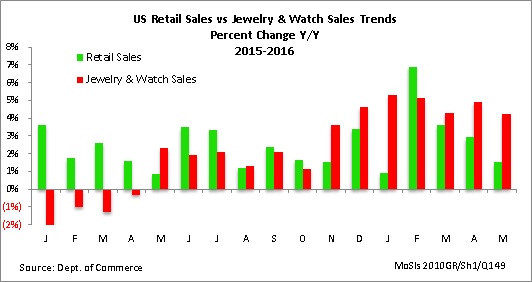
Outlook – We Remain Optimistic
The US retail jewelry sector has been relatively robust since the all-important November-December period, based on revised data. Jewelry demand during the first five months of 2016 has remained consistently strong for the overall industry.